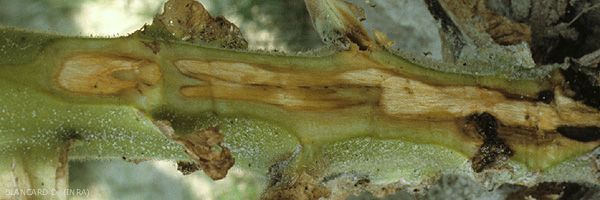
Ralstonia solanacearum
(Smith 1896) Yabuuchi et al. (1996)
Bacterial wilt of tobacco
- synonyms : Burkholderia solanacearum, Pseudomonas solanacearum
- English names : Bacterial wilt, Granville wilt
Ralstonia solanacearum is a highly polyphagous bacterium. It includes several strains that differ namely in their ability to metabolise various sugars and denitrification of nitrates, as well as in their distinct host range. Based on the latter, it seems that R. solanacearum can be separated into five physiological races :
- Race 1, with many strains isolated from different regions and hosts;
- Race 2, adapted to the triploid banana trees in the tropics;
- Race 3, preferentially attacking the potato, tomato, and eggplant in temperate climates;
- Race 4, associated with ginger;
- Race 5, affecting the mulberry tree.
There is little information about the "tobacco" strains belonging to these physiological races. It has been reported that some "tobacco" strains do not seem to be able to attack tomato and eggplant, that "potato" strains have little affect on tobacco. "Banana" strains seem unable to infect tobacco.
Bacterial wilt occurs mainly in tropical, semitropical and warm temperate zones. It is particularly severe in many Asian countries (China, Japan, Malaysia, Pakistan, Thailand, Vietnam), of America (USA, Brazil) and Africa (including South Africa). Ralstonia solanacearum is quite rare in Europe. It has been reported in Hungary, Italy and Yugoslavia. It has not been reported currently on tobacco in France. In the countries where Ralstonia solanacearum is endemic it is a feared disease which can cause serious damage on tobacco and other crops.
U.S. situation
In the southeastern U.S. differences in bacterial wilt incidence among crops have been attributed to the type of avirulence gene, avrA that determines race specificity by limiting the range of host cultivars, host species and genera the pathogen can attack. Two types of avrA gene have been identified, the wilt and the mutated type. In a study conducted in early 2000 tobacco strains had all the mutated avrA gene. On the other hand, in another study conducted recently in North Carolina where several strains from tobacco fields were examined it was found that those strains are genetically very closely related to each other, basically clustering in a single clone.
(Mina Mila - North Carolina State University)





